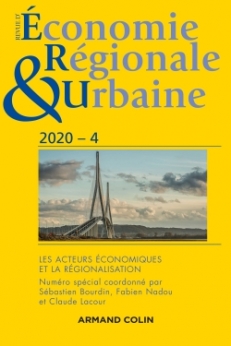
Revue d'économie régionale et urbaine (4/2020)
Pour acheter ce numéro, contactez-nous
Recevez les numéros de l'année en cours et accédez à l'intégralité des articles en ligne.
Certaines critiques de la formulation initiale de la théorie de la base économique ont mis en avant la nécessité de prendre en compte les interactions spatiales entre les bases économiques de régions proches pour mieux saisir les déterminants de la croissance économique locale. Après avoir examiné ces critiques, nous montrons qu’une politique publique visant la coopération spatiale entre les bases économiques de deux régions proches serait plus efficace qu’une politique publique cherchant uniquement à favoriser une meilleure interaction spatiale entre la base économique et l’économie domestique d’une même région. Pour cela, nous employons un modèle keynésien élémentaire dans lequel nous introduisons les effets de rétroaction entre les bases économiques de régions voisines.
Some criticisms of the original formulation of the Economic Base Theory have stressed on one of their shortcomings: the identification of local economic growth without considering the integration of the spatial interactions and their feedback effects between neighbouring regions’ economic bases. The omission of these effects has prevented the original Economic Base Theory authors from estimating correctly the economic base multiplier. Their focus of the dependence between exporting base and domestic economy resulted in a negligence of the necessity to promote spatial cooperation for achieving local economic development. After reviewing the controversies around the definition of an suitable scale of analysis and presenting the different approaches of the Economic Base Theory, we show that a public policy aiming to foster cooperation between neighbouring regions’ economic bases, would be more efficient than a policy which only seeks to promote a better interaction between the economic base and the domestic economy within a given region. This performance is especially due to the link from the exports of the region “A” and the income of the region “B”. Then, taking into account this result as assumption and using estimations for all the parameters needed, we use an elementary Keynesian model with feedback effects between regions’ economic bases. We compare it with another model being unaware of these feedback effects in order to measure the benefits of public policy aiming for a spatial cooperation development. Finally, we suggest an example showing what kind of spatial cooperation that public authorities could design by using our Economic Base Theory model.